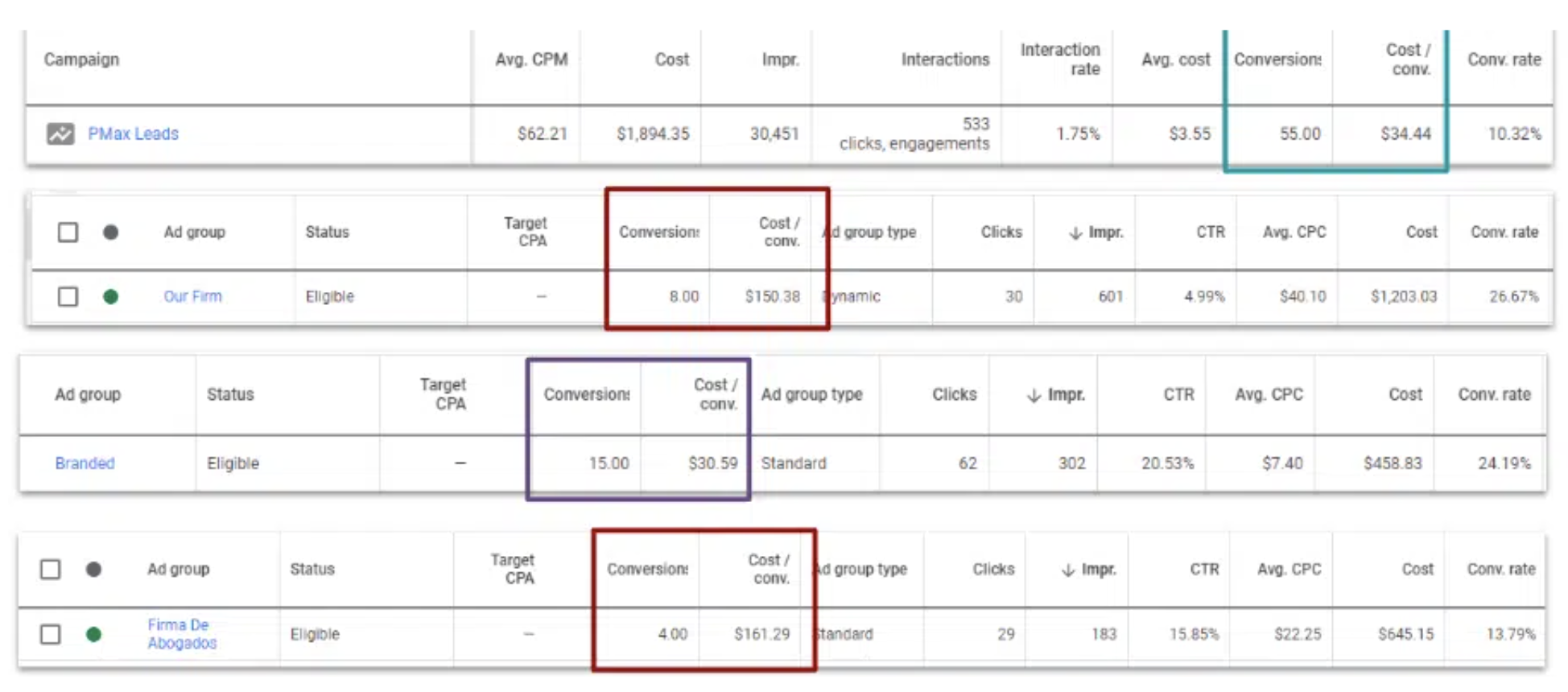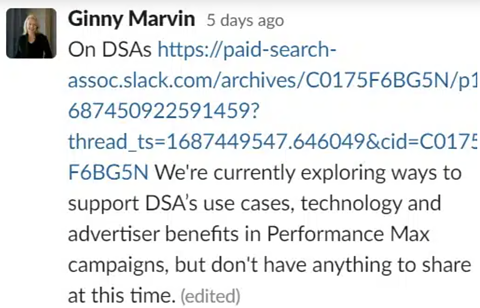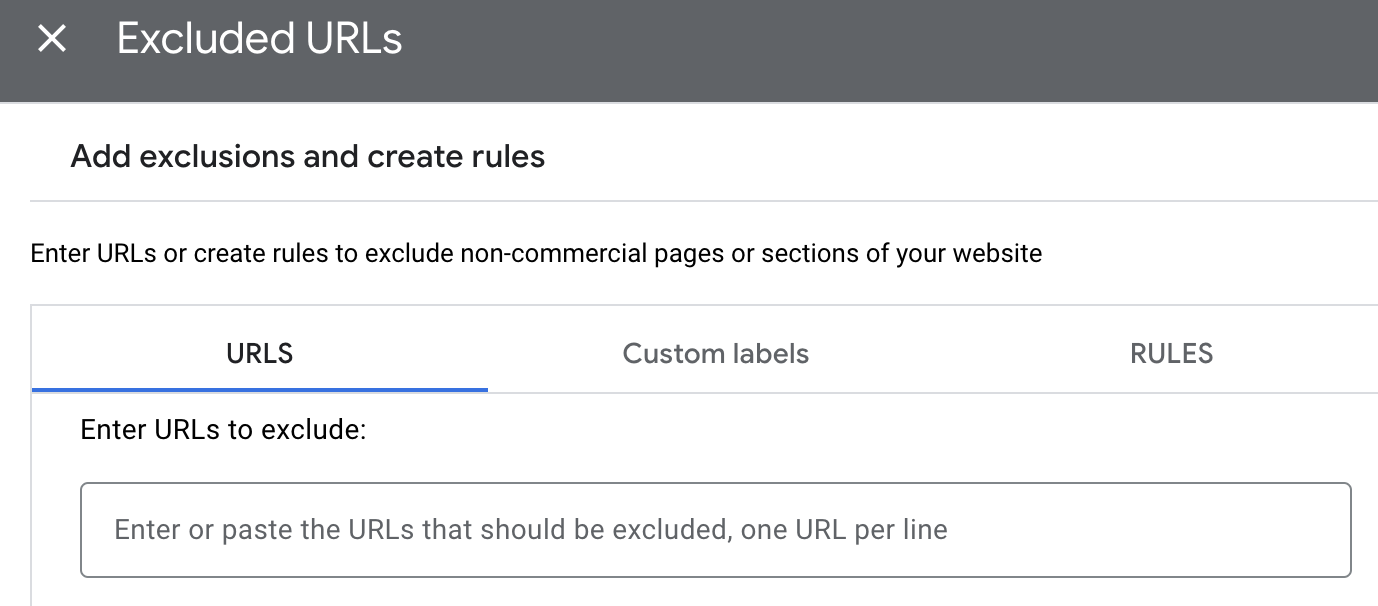Change is the only constant, especially in digital advertising – and you’ve probably heard some whispers about Dynamic Search Ads (DSA) taking a backseat to Performance Max (PMax).
While Google hasn’t announced a sunset of DSA, it’s worth figuring out how to use Google’s new darling – PMax – to achieve similar results.
Let’s look at what’s happening to these two ways to automatically run ads for your site, and cover how to switch from DSA to PMax to get ahead of the inevitable transition.
Performance Max Campaigns Eclipse DSAs
DSAs have been a reliable tool for advertisers for several years, allowing businesses across industries to harness their organic search strength for PPC campaigns.
Despite their effectiveness, there’s an observable shift towards PMax campaigns.
 Screenshot from Navah Hopkins from Optmyzr, August 2023
Screenshot from Navah Hopkins from Optmyzr, August 2023See the CPA and lead volume in an account running DSA and PMax with URL expansion.
PMax campaign drives more conversions at a better CPA than DSA ad groups in the same account.
Many advertisers have reported a similar shift and now see fewer impressions to DSAs that used to drive significant volumes. And that shift away from DSA impressions is especially noticeable in accounts that also have PMax campaigns.
Even though Google hasn’t released an official statement, indicators point towards PMax campaigns eventually replacing DSAs.
-
 Screenshot from X.com, August 2023
Screenshot from X.com, August 2023
Google hints that DSA’s capabilities may be replaced by PMax. To me, this inevitable transition makes sense.
DSAs were created to automatically create ads to fill in gaps in advertisers’ search campaigns. PMax takes that type of automation to the next level with the latest machine-learning capabilities from Google.
PMax can do what DSAs did and then some. Maintaining both systems wouldn’t make sense for Google.
While there’s speculation that PMax may eventually usurp other campaign types like search, too, this makes less sense because search campaigns have always had a significant manual element of advertiser control, which is very different from what PMax offers.
It takes just a few inputs and automates many of the details.
Forcing advertisers to use this much more automated campaign type will take a lot more convincing, especially for larger advertisers who have crafted meticulous strategies to get the very best results from their manual campaigns.
What Is Gained In A Shift From DSA To PMax
There are several important differences between PMax and DSA, including the types of ads that can be served and the types of placements available.
As you prepare to migrate from DSAs to PMax, it’s important to understand these differences so that you can take advantage of all the capabilities.
Multi-Ad Formats
One of the key benefits of PMax campaigns is their support for multiple ad formats. Unlike DSAs, PMax campaigns encompass text, display, and video ads.
This variety allows advertisers to cater to a wider audience, enhancing the user experience with different formats that appeal to diverse consumer preferences.
While PMax ads still rely heavily on advertiser-provided content for ads, Google has showcased their future ability to generate ad assets automatically based on website and YouTube content.
On the other hand, DSA campaigns’ ability to automate ads relies on the SEO of the landing pages. PMax, meanwhile, will use the newest generative AI technology, like Google’s PaLM2, to generate a wider variety of ad creative.
This innovation is happening in PMax campaigns and not in DSA campaigns which seem to be in maintenance mode only.
Thinking about one of the key value props for DSAs is that advertisers with good on-site SEO could leverage this to get more complete ad coverage.
But clearly, the web is about more than just text. So it makes sense for DSAs to also evolve towards including images and video.
But since all that development around automating ad assets is focused around PMax, this campaign type will likely continue to take away volume from DSAs and eventually take over completely.
As PMax more fully utilizes all the site’s assets, it’s likely that the resulting ads will be more compelling to consumers and drive more engagement with the advertiser’s site.
Next, let’s take a closer look at another key difference between the campaign types and how they can serve ads in different places.
Multi-Channel
Another compelling feature of PMax campaigns is their cross-channel functionality. PMax runs across various channels like YouTube, Display, Search, Discover, Gmail, and Maps.
This means advertisers can maintain fewer campaigns yet reach their audience on a broader scale, thus streamlining their advertising efforts and potentially leading to more efficient campaign management.
The notion that fewer campaigns are preferable to more campaigns is largely Google’s stance. To me, this only makes sense when considering less sophisticated advertisers.
More sophisticated advertisers, like those reading this site, will still benefit from the additional control that is gained by running more campaigns.
For example, an advertiser with a large product catalog could segment their products into different campaigns based on profit margins.
This is a simple yet effective technique for optimizing PPC towards a profit goal rather than a revenue maximization goal.
By creating several PMax campaigns, advertisers can set target return on ad spend (ROAS) levels that ensure the profitability of each campaign.
Next, let’s take a look at how the campaigns differ in how ads are dynamically targeted to an advertiser’s entire website.
Dynamic Targeting Settings
DSAs had the notable advantage of allowing advertisers to specify which parts of their website they wanted to advertise.
This function gave advertisers more control over their campaigns. For example, they could create a dynamic ad group for a specific landing page or a group of landing pages.
PMax can also do this but approaches it differently.
PMax doesn’t provide URL specification but rather allows for URL expansion. Ads can then be dynamically created to lead users to any page on the site that qualifies according to the URL expansion rules.
So with PMax, URL expansion is an on-off switch rather than a list of URLs that should be targeted.
To allow advertisers some control, it does allow setting exclusions or rules for excluding parts of their site from being included in URL expansion.
 Screenshot by author from Google, August 2023
Screenshot by author from Google, August 2023PMax campaigns with URL expansion can set rules for excluding portions of the site from automated ad targeting.
It’s a shift in perspective – instead of choosing what to include, with PMax, you’re selecting what to exclude.
While this may require a different approach, the end result is similar – you can ensure that only the relevant parts of your website are advertised.
For example, an advertiser who wants to advertise only products in their electronics section could target URLs containing ‘electronics’ in a DSA dynamic ad group.
In a PMax campaign, the same can be achieved by excluding all other URLs besides the ones containing “electronics.”
Performance
Now that we’ve explored the transition from DSA to PMax, it’s time to focus on another critical piece of the puzzle – measuring campaign performance.
With DSAs, performance measurement is often centered around the last-click, transactional model.
We aimed to lead our audience to a sale; if it didn’t, we considered it a miss. Simple, right? Well, with PMax, we need to recalibrate our performance yardstick.
PMax’s impressive range of ad formats and multi-network functionality means it can serve as more than just a direct sales tool. PMax has the potential to excel as an upper funnel, attribution, and awareness campaign, too.
Let’s say, for instance, you run a video ad campaign on YouTube using PMax. Even if a viewer doesn’t immediately click through to your website and make a purchase, the campaign is still valuable.
It raises brand awareness, introduces potential customers to your products, and leaves an impression. That’s the beauty of PMax – it extends your reach, spreading your brand message far and wide.
And in doing so, it builds awareness for your brand, often at cost per click (CPCs) that are quite affordable when compared to the typical CPC for a bottom-of-the-funnel click.
With this shift in focus, our success metrics must evolve, too.
Instead of just tracking last-click conversions, we need to pay attention to impressions, brand recall, engagement rates, and all the other factors that guide a user from the early stages of their consumer journey all the way through the final conversion.
Data-driven attribution is an excellent option to measure campaign performance more holistically.
It’s all about understanding the wider customer journey and appreciating the role of PMax in contributing to your brand’s larger narrative.
Conclusion
So while there is no specific date at which DSAs will be replaced by Performance Max campaigns, the ongoing development that is making PMax more capable means there will be a continuing decline in DSA performance.
Advertisers who enjoy the additional volume provided by a system that automatically matches landing pages on their site to user queries should consider migrating from DSAs to PMax at some point soon.
More resources:
Featured Image: 3rdtimeluckystudio/Shutterstock
